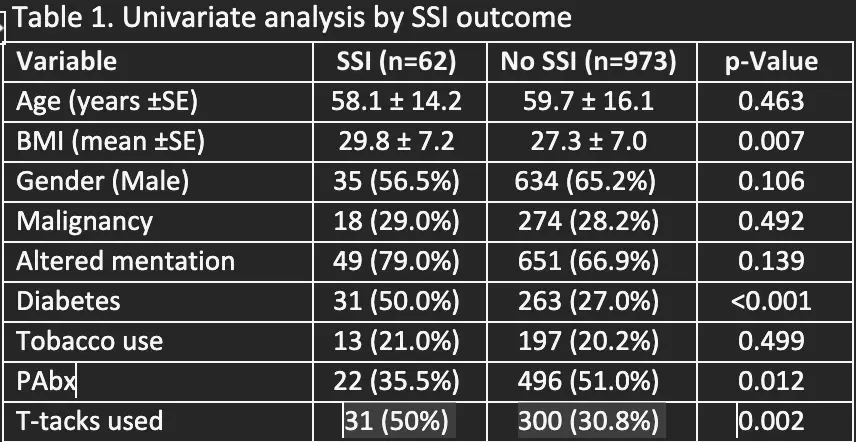The Impact of Perioperative Antibiotics and T-Tacks in Surgical Site Infections after PEG
Author(s):
Samuel Seigler; Sevanna Boleman; Bryce Lambert; Bruce Crookes; Evert Eriksson; Heather Evans
Background:
Surgical site infection (SSI) is a common complication after percutaneous endoscopic gastrostomy (PEG). Perioperative antibiotics (PAbx) are indicated for clean-contaminated cases; use has been shown to decrease risk of peristomal infection after PEG. T-Tacks have been advocated to prevent intra-abdominal complications, but risk of local infection is unknown.
Hypothesis:
We sought to review practice of PAbx prior to PEG placement and identify risk factors for SSI.
Methods:
We conducted a quality improvement review of medical records of patients who underwent PEG from 2017-2022 at a single Level 1 Trauma center. Univariate analysis was used to compare groups by the primary outcome of interest, SSI. Using backward stepwise logistic regression, we performed multivariate analysis to identify predictors of developing SSI. Classification and regression tree (CART) analysis was used to further analyze relationships between variables.
Results:
Of 1035 PEG patients, 62 (5.99%) developed SSI. On univariate analysis, SSI patients had higher mean body mass index (BMI) and were more likely to have diabetes (DM) (Table 1). SSI was associated with failure to use PAbx and use of T-tacks. On multivariate analysis, SSI risk was 169% higher in DM patients (OR 2.692 [95% CI 1.597,4.538]) and 113% higher with the use of t-tacks (OR 2.125 [95% CI 1.259,3.588]). Those who received PAbx were 44% less likely to develop SSI (OR 0.563 [95% CI 0.327,0.969]). CART analysis demonstrated that of 294 (28.4%) patients with DM, 31 (10.5%) developed SSI while only 31 (4.2%) of the 741 (71.6%) non-DM patients developed SSI. Of 97 (9.4%) patients with DM that received t-tacks, 16 (16.5%) developed SSI compared to only 15 (7.6%) SSI in the 197 (19%) patients with DM who did not receive t-tacks. Of 234 (22.6%) non-DM patients who received t-tacks, 15 (6.4%) developed SSI compared to only 16 (3.2%) SSI in the 507 (49%) that did not receive T-tacks. In the 105 (10.1%) non-DM patients who received t-tacks and PAbx, 3 (2.9%) developed SSI vs 12 (9.3%) of the 129 (9.3%) who did not receive PAbx.

Conclusions:
Use of PAbx in PEG placement is associated with lower rates of SSI. Further investigation into interaction between patient and procedural risk factors is planned to generate guidance for pre-PEG risk stratification regarding T-Tacks.

